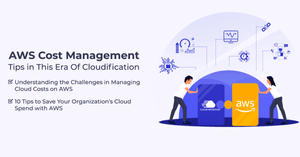What are Cloud Cost Management Tools?
Cloud cost management tools help companies keep a close eye on their spending by monitoring how they use cloud resources and computing services. They are particularly useful when a company opts for an Infrastructure-as-a-Service (IaaS) model, where they pay for what they use. These cloud cost management software solutions serve as a cost-saving platform that notifies users of any reduced demand and automatically adjusts resource usage to more cost-effective levels.
In addition to cost control, these cloud cost management platforms enhance efficiency in cloud service usage. They offer reporting features that identify areas of waste and redundancy. While these tools share similarities with SaaS cost management tools, it's important to note that they primarily focus on optimizing cloud infrastructure spending rather than cloud applications.
What are the Different Types of Cloud Costs?
Here are different types of cloud cost models, each offering unique advantages and considerations for businesses looking to manage their cloud expenses;
- Pay-As-You-Go: In the Pay-As-You-Go cloud cost model, services are billed based on your actual usage. You're charged for the resources you consume, such as computing power, storage, and networking, as you use them. The advantage of this model is that you pay only for what you use, and you can easily scale resources up or down as your needs change. However, it's important to be cautious as adding more resources can lead to increased ongoing costs.
- Prepaid/Fixed Subscriptions: Prepaid or fixed subscription models require an upfront payment for a predetermined package of cloud services for a set time period. Longer subscription durations come with reduced per-service costs. This type is mostly used for services that include both hardware and software, such as PaaS and SaaS.
- Reserved Instances: Reserved Instances involve a commitment to specific cloud resources for an extended period, usually 1 or 3 years. The discount you receive depends on the commitment's length and the upfront payment made at the start of the period. Usually, a three-year commitment provides the best cost efficiency. Cloud providers frequently grant discounts of 50% to 75% when compared to pay-as-you-go rates for reserved instances with similar capabilities.
- AWS Savings Plan: AWS Savings Plans, much like reserved instances, present a flexible pricing structure. Organizations commit to a one-year or three-year specific usage of AWS services in exchange for lower-than-on-demand pricing. AWS provides three types of Savings Plans:
- Compute Savings Plans: These cover all Amazon computing services, such as Amazon EC2, AWS Lambda, and Fargate.
- EC2 Savings Plans: These are specifically for Amazon EC2 instances.
- SageMaker Savings Plans: SageMaker Savings Plans are tailored to optimize costs specifically for Amazon SageMaker usage within the AWS cloud ecosystem.
Savings plans offer three payment methods:
- No upfront: This option doesn't require an upfront payment and bills according to monthly usage, offering minimal savings.
- Partial upfront payment: More than half of the contract is prepaid, with the rest billed monthly, providing additional discounts.
- Full upfront payment: The whole obligation is paid in advance, providing the most substantial discount.
- Spot Instances: Spot instances are generally the most budget-friendly computing choice, providing reductions of up to 90% when contrasted with pay-as-you-go rates. Cloud providers use them to sell spare capacity. However, they can be interrupted with very short notice, making them suitable for non-mission-critical workloads where brief interruptions are acceptable due to substantial cost savings.
Who Uses Cloud Cost Management Tools?
Various professionals and teams use multi-cloud cost management tools to effectively and efficiently manage cloud-related expenses. Here is who these users are and how they benefit from these tools;
- Cloud Architects: Cloud architects are the primary users of cloud cost management software. Their responsibilities include optimizing cloud spending and resource utilization. Cloud architects are not limited to technical aspects of the tools but they also collaborate closely with departments like HR, finance, logistics, and security to ensure that cloud strategies are fine-tuned and budget-friendly.
- Cloud Cost Managers: Cloud cost managers wear many hats, including handling forecasting, budgeting, identifying trends and opportunities, and implementing best practices for cloud governance. These professionals utilize the analytics dashboard provided by cloud cost monitoring tools to keep a watchful eye on cloud strategies. They use insights gained from the tool to propose changes and suggestions to decision-makers.
- IT Teams and Admins: IT teams and administrators use cloud cost management tools to optimize cloud infrastructure and ensure that all resources are used judiciously. These cloud cost tools empower IT admins to set up real-time monitoring, establish budgets, and configure notifications and alerts.
- Cross-Functional Teams: Numerous cross-functional teams, such as engineering, application development, and testing teams, depend on cloud resources to expedite product development and reduce time-to-market. Heads of these multi-departmental teams oversee cloud expenses to confirm they match the designated budget.
- Cloud Service Providers: Cloud service providers provide choices for cloud cost optimization tools as part of their service offerings. They also provide customers with internal cost management solutions that are reliable, scalable, and readily available.
What are the Features of Cloud Cost Management Tools?
Cloud cost management software offers a range of features that are invaluable for companies seeking to gain control over their cloud expenses. Here are some of the core features of these tools;
- Automatic Scaling: Automatic scaling is a feature that ensures resources are available when needed and automatically powered down when not in use. This helps companies avoid unnecessary spending on idle cloud resources. The software automates the governance of costs, compliance, security, and cloud operations.
- Instance Management: A significant cost driver in cloud computing is the presence of unused instances. Cloud cost optimization tools monitor instances and alert users when an instance is not actively in use, providing opportunities to save costs. Additionally, the software can identify discount instances suitable for non-critical workloads that don't require continuous running, resulting in further cost savings.
- Automated Alerts and Notifications: Cloud spend management tools enable users to configure automated alerts and budgets. These alerts serve as early warning systems, notifying users of critical events such as authorization failures, sudden cost spikes, untagged infrastructure, and budget overages.
- Cost Allocation: A fundamental feature of cloud cost management tools is cost allocation. It allows users to monitor and track team spending on cloud computing resources. This feature is invaluable for management as it facilitates the establishment of appropriate budgets and the tracking of expenses by different company functions.
- Chargeback: Chargeback is a feature that enables the cost of cloud services to be attributed or "charged back" to the specific business unit responsible for incurring the cloud expenses. Different cloud cost management platforms offer chargeback capabilities. This feature allows companies to identify the departments that are making the most (and least) use of cloud resources.
Key Benefits of Cloud Cost Management Tools
Cloud cost management software offers a range of benefits that are vital for businesses looking to streamline their cloud expenses and optimize their operations;
- Reduce Costs: The most compelling benefit of cloud cost management software is its ability to significantly reduce cloud-related expenses. These tools enable companies to monitor and track their cloud spending meticulously. By doing so, they can ensure optimal resource allocation and take advantage of discounts offered by leading cloud service providers.
- Eliminate Waste: By gaining insights into their cloud usage and costs, organizations can effectively eliminate waste and ensure optimal utilization of their cloud resources. This is achieved through techniques such as automatic scaling and load balancing. The result is more efficient resource utilization and cost savings.
- Gain Visibility into Cloud Storage Costs: Cloud spend management tools offer a clear view of cloud resource costs, including those that remain idle or are overutilized. Some software provides detailed hourly granularity. Single-pane-of-glass dashboards empower administrators to efficiently manage, organize, and optimize their cloud environments from a central location.
- Get Cost-Cutting Recommendations: Cost-cutting recommendations are based on a thorough analysis of different workloads and their specific cloud requirements. Cloud cost software dives deep into cost sources and offers actionable suggestions to users, leading to significant savings.
- Improve Reporting and Analytics: Data-driven decision-making is crucial for effective cloud cost management. Cloud cost analysis tools track spending patterns and provide users with graphical or tabular data for in-depth analysis. These analytics can be cross-referenced with business outcomes.
Top Cloud Cost Management Tools
Here is a list of some of the best cloud cost management tools;
| Software | Features | Price |
| ManageEngine Cloud Spend | Cost Management, Data Visualizations, Data Storage, Dashboard, Data Import/Export | Price On Request |
| Cast AI | Data Visualizations, Data Storage, Cost Reduction Optimization, Dashboard, Roles & Permissions | $200 |
| ProsperOps | Data Visualizations, Dashboard, Data Storage, Roles & Permissions, Reporting & Analytics | Price On Request |
| Finout | Data Visualizations, Data Storage, Data Import/Export, Dashboard, Reporting & Analytics | $500 |
| CloudKeeper | Cost Optimization, Reporting & Analytics, Dashboard, Cost Reduction Optimization, Roles & Permissions | Price On Request |
| CloudCheckr | Cost Optimization, Dashboard, Reporting & Analytics, Cost Reduction Optimization, Spend and Cost Reporting | Price On Request |
| nOps | Change Management, Cloud Management, Data Visualizations, Compliance Management, Audit Trail | Price On Request |
| Kubecost | Dashboard, Roles & Permissions, Data Import/Export, Data Visualizations, Unified Cost Monitoring | Price On Request |
| Cloudzero | Cost Management, Data Visualizations, Data Storage, Dashboard, Data Import/Export | Price On Request |
| Virtana | Cost Management, Change Management, Customizable Savings Policies, Reporting & Analytics, Dashboard | $5 |
Factors to Consider When Buying Cloud Cost Management Tools
Before buying the best cloud cost optimization software, it's essential to consider several key factors:
- Requirements Gathering (RFI/RFP) for Cloud Cost Management Tools: One should start hunting for the best cloud cost management tools by looking into what challenges it can address by understanding and identifying areas of cloud spending inefficiency. Here are some common issues that can lead to soaring cloud costs;
- Resource Oversizing: Companies often invest in more cloud resources than necessary, resulting in unused capacity and increased cloud expenses. Proper rightsizing can prevent these unnecessary costs.
- Software Efficiency: Managing cloud storage expenses can be complex in a multi-team environment. Failing to measure software efficiency or set performance targets can lead to increased cloud resource wastage.
- Forecasting Difficulties: Inaccurate forecasting can lead to unexpected costs when a company is unprepared for additional requirements, such as developing new services or modifying existing ones.
- Architectural Design Challenges: Poor architectural design can result in unforeseen expenses, including workloads incompatible with specific cloud environments, additional licensing needs, and governance issues. Addressing these concerns is crucial for cost control.
- Cost Tracking and Reporting Capabilities: Comprehensive cost tracking and reporting are crucial in cloud cost management tools, providing real-time spending visibility and insights for cost-saving opportunities.
- Scalability and Integration: Evaluate the tool's scalability for accommodating growth and ensure seamless integration with existing cloud infrastructure and software systems for a smoother transition to efficient cloud management.
- Cost Optimization Techniques: Cloud cost optimization tools provide access to cost optimization techniques, including auto-scaling, rightsizing, and cost-cutting recommendations in the software, promoting efficiency and cost savings.
- User-Friendly Interface: The software should have a user-friendly interface so that your team can easily navigate and make the most of the tool. Training requirements should be minimal to enable efficient adoption.
- Total Cost of Ownership (TCO): Evaluate the complete ownership expenses, encompassing licensing fees, subscription charges, and any extra costs linked to the tool. A clear understanding of the TCO helps in budgeting and cost management.



























